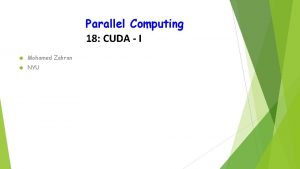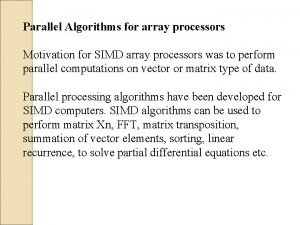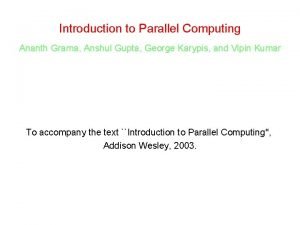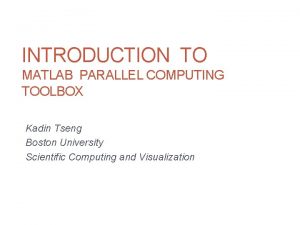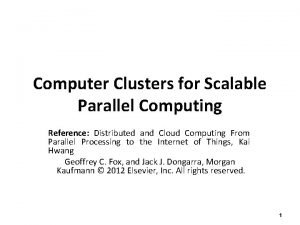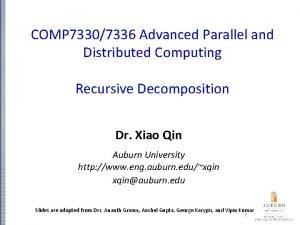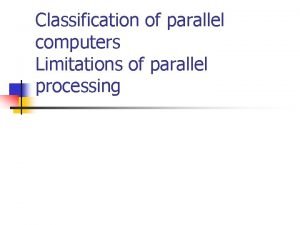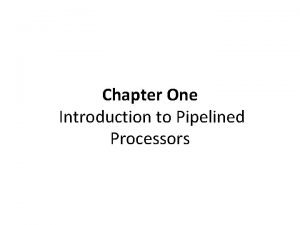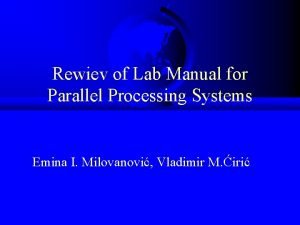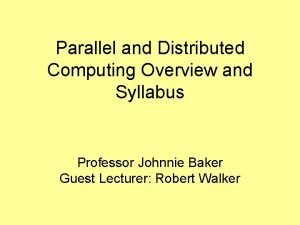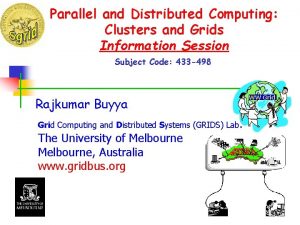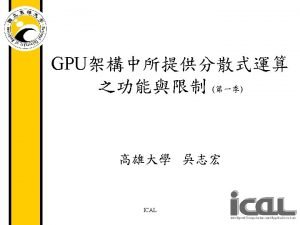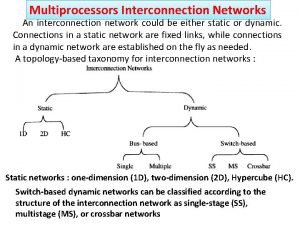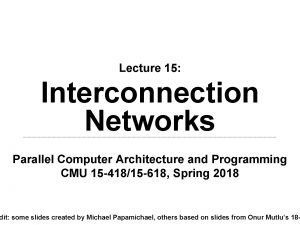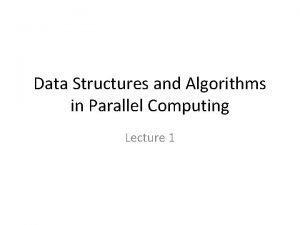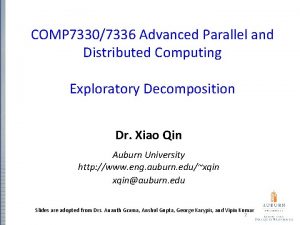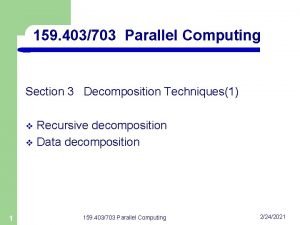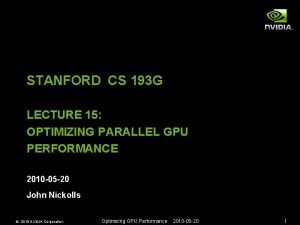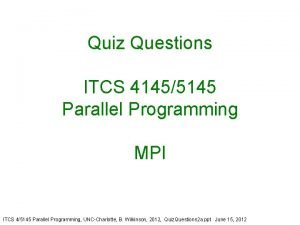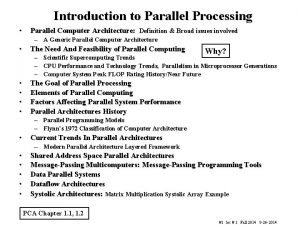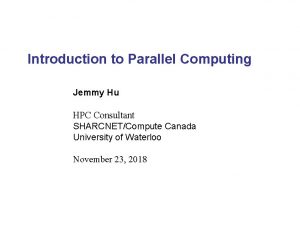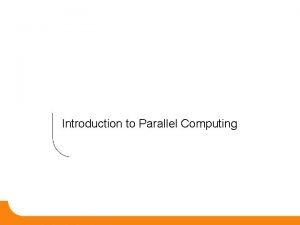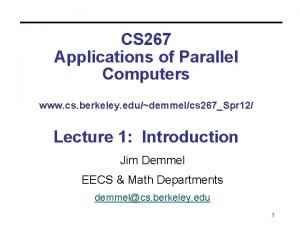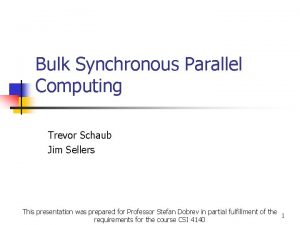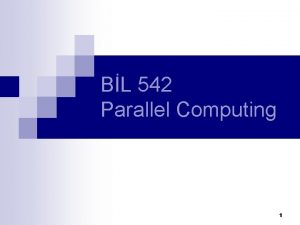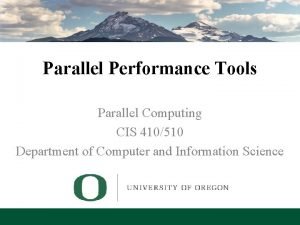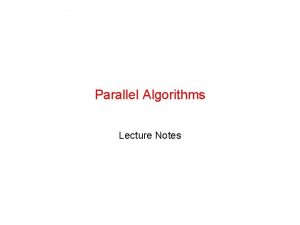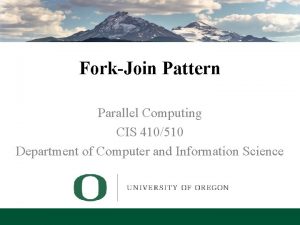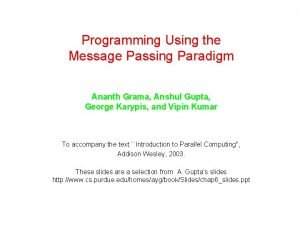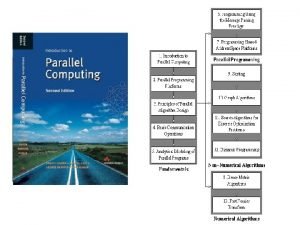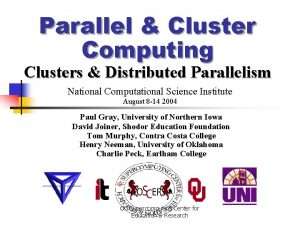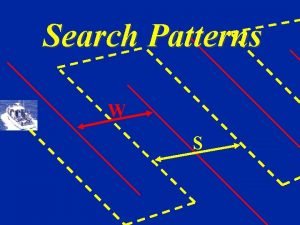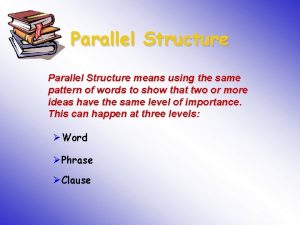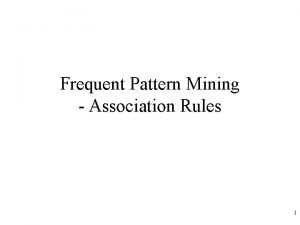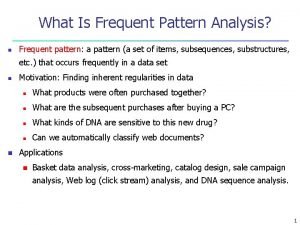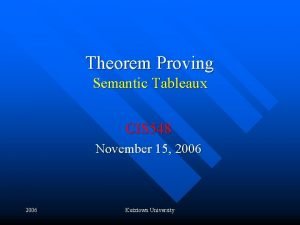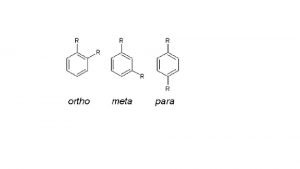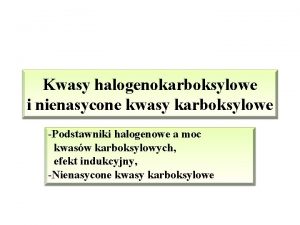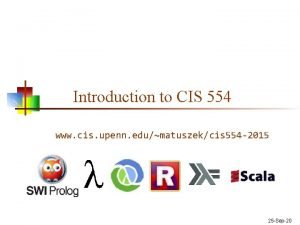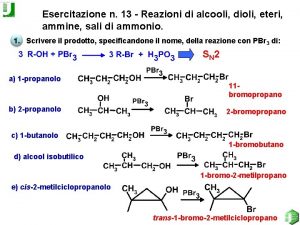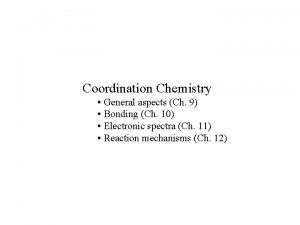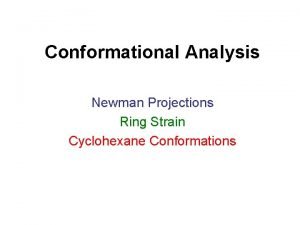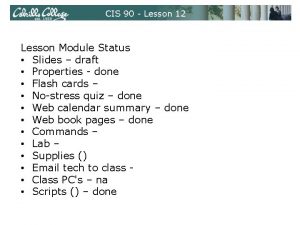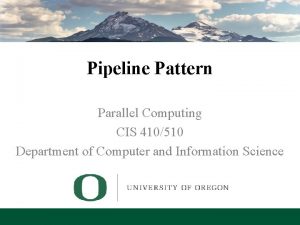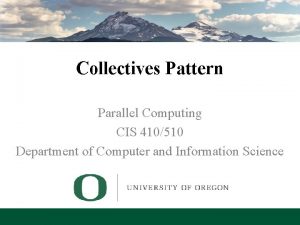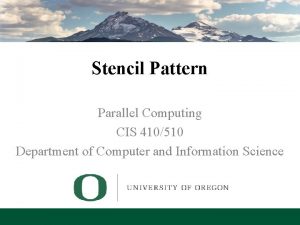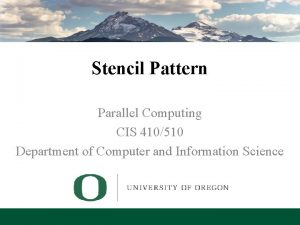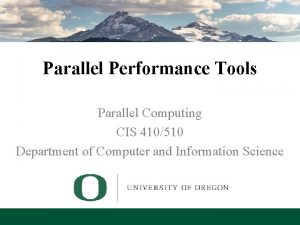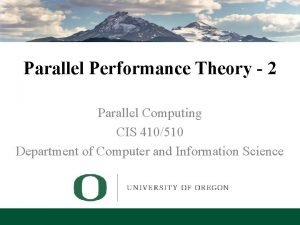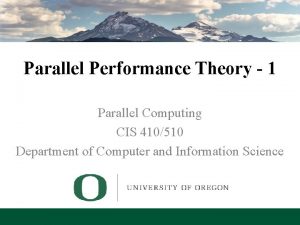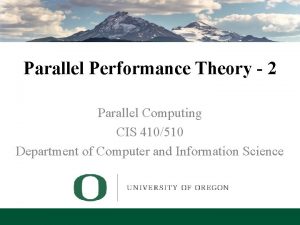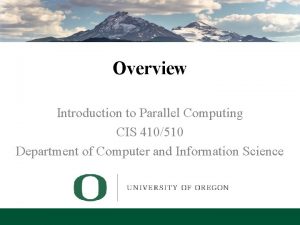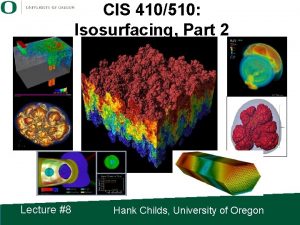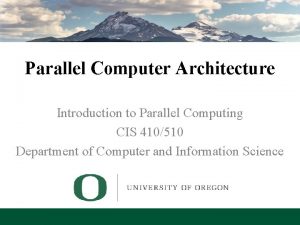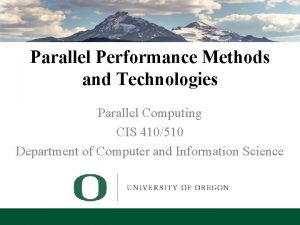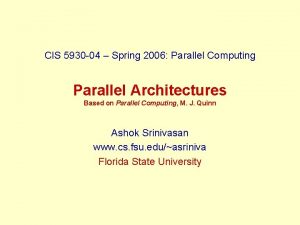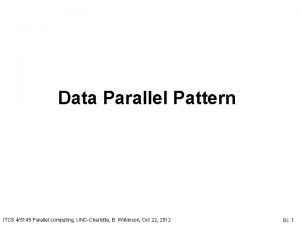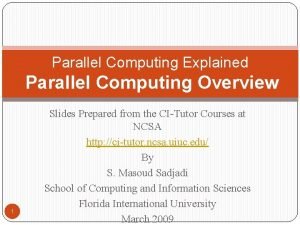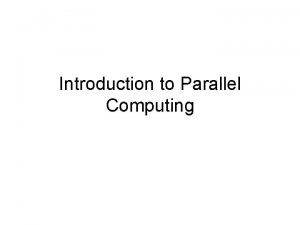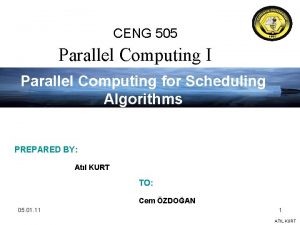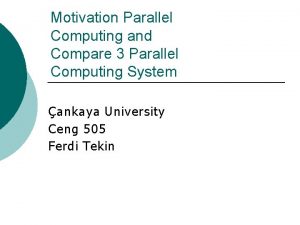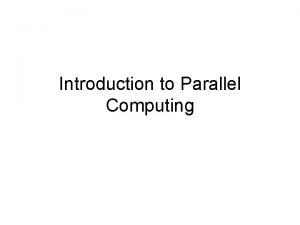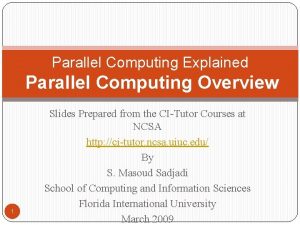ForkJoin Pattern Parallel Computing CIS 410510 Department of







































![PARALLEL DO: Syntax r Fortran !$omp parallel do [clause [, ] [clause …]] do PARALLEL DO: Syntax r Fortran !$omp parallel do [clause [, ] [clause …]] do](https://slidetodoc.com/presentation_image_h2/58837d893cdd845a0256cb5744076b81/image-40.jpg)







![PARALLEL Directive r Fortran !$omp parallel [clause [, ] [clause …]] structured block !$omp PARALLEL Directive r Fortran !$omp parallel [clause [, ] [clause …]] structured block !$omp](https://slidetodoc.com/presentation_image_h2/58837d893cdd845a0256cb5744076b81/image-48.jpg)

![Example: Parallel Region double A[1000]; omp_set_num_threads(4); #pragma omp parallel { int ID = omp_thread_num(); Example: Parallel Region double A[1000]; omp_set_num_threads(4); #pragma omp parallel { int ID = omp_thread_num();](https://slidetodoc.com/presentation_image_h2/58837d893cdd845a0256cb5744076b81/image-50.jpg)






![SECTIONS Directive r Fortran !$omp sections [clause [, ] [clause …]] [!$omp section] code SECTIONS Directive r Fortran !$omp sections [clause [, ] [clause …]] [!$omp section] code](https://slidetodoc.com/presentation_image_h2/58837d893cdd845a0256cb5744076b81/image-57.jpg)




















- Slides: 77

Fork-Join Pattern Parallel Computing CIS 410/510 Department of Computer and Information Science Lecture 9 – Fork-Join Pattern

Outline What is the fork-join concept? q What is the fork-join pattern? q Programming Model Support for Fork-Join q Recursive Implementation of Map q Choosing Base Cases q Load Balancing q Cache Locality and Cache-Oblivious Algorithms q Implementing Scan with Fork-Join q Applying Fork-Join to Recurrences q Introduction to Parallel Computing, University of Oregon, IPCC Lecture 9 – Fork-Join Pattern 2

Fork-Join Philosophy When you come to a fork in the road, take it. (Yogi Bera, 1925 –) Introduction to Parallel Computing, University of Oregon, IPCC Lecture 9 – Fork-Join Pattern 3

Fork-Join Concept Fork-Join is a fundamental way (primitive) of expressing concurrency within a computation q Fork is called by a (logical) thread (parent) to create a new (logical) thread (child) of concurrency q ❍ Parent continues after the Fork operation ❍ Child begins operation separate from the parent ❍ Fork creates concurrency q Join is called by both the parent and child ❍ Child calls Join after it finishes (implicitly on exit) ❍ Parent waits until child joins (continues afterwards) ❍ Join removes concurrency because child exits Introduction to Parallel Computing, University of Oregon, IPCC Lecture 9 – Fork-Join Pattern 4

Fork-Join Concurrency Semantics q Fork-Join is a concurrency control mechanism ❍ Fork increases concurrency ❍ Join decreases concurrency q Fork-Join dependency rules ❍A parent must join with its forked children ❍ Forked children with the same parent can join with the parent in any order ❍ A child can not join with its parent until it has joined with all of its children q Fork-Join creates a special type of DAG ❍ What do they look like? Introduction to Parallel Computing, University of Oregon, IPCC Lecture 9 – Fork-Join Pattern 5

Fork Operation Fork creates a child thread q What does the child do? q Typically, fork operates by assigning the child thread with some piece of “work” q ❍ Child thread performs the piece of work and then exits by calling join with the parent Child work is usually specified by providing the child with a function to call on startup q Nature of the child work relative to the parent is not specified q Introduction to Parallel Computing, University of Oregon, IPCC Lecture 9 – Fork-Join Pattern 6

Join Operation Join informs the parent that the child has finished q Child thread notifies the parent and then exits q ❍ Might q provide some status back to the parent Parent thread waits for the child thread to join ❍ Continues q after the child thread joins Two scenarios 1. Child joins first, then parent joins with no waiting 2. Parent joins first and waits, child joins and parent then continues Introduction to Parallel Computing, University of Oregon, IPCC Lecture 9 – Fork-Join Pattern 7

Fork-Join Heritage in Unix Fork-Join comes from basic forms of creating processes and threads in operating system q Forking a child process from a parent process q ❍ Creates a new child process with fork() ❍ Process state of parent is copied to child process ◆process ID of parent stored in child process state ◆process ID of child stored in parent process state ❍ Parent process continues to next PC on fork() return ❍ Child process starts execution at next PC ◆process ID is automatically set to child process ◆child can call exec() to overlay another program Introduction to Parallel Computing, University of Oregon, IPCC Lecture 9 – Fork-Join Pattern 8

Fork-Join Heritage in Unix (2) q Joining a child process with a parent process ❍ Child process exits and parent process is notified ◆if parent is blocked waiting, it unblocks ◆if parent is not waiting, some indication is made ◆child process effectively joins ❍ Parent process calls waitpid() (effectively join) for a particular child process ◆if the child process has called join(), parent continues ◆if the child process has not called join(), parent blocks q Fork-Join also implemented for threads Introduction to Parallel Computing, University of Oregon, IPCC Lecture 9 – Fork-Join Pattern 9

Fork-Join “Hello World” in Unix Introduction to Parallel Computing, University of Oregon, IPCC Lecture 9 – Fork-Join Pattern 10

Fork-Join in POSIX Thread Programming q POSIX standard multi-threading interface ❍ For general multi-threaded concurrent programming ❍ Largely independent across implementations ❍ Broadly supported on different platforms ❍ Common target for library and language implementation q Provides primitives for ❍ Thread creation and management ❍ Synchronization Introduction to Parallel Computing, University of Oregon, IPCC Lecture 9 – Fork-Join Pattern 11

Thread Creation #include <pthread. h> int pthread_create( pthread_t *thread_id, const pthread_attr_t *attribute, void *(*thread_function)(void *), void *arg); q thread_id ❍ thread’s q attribute ❍ contain q details on scheduling policy, priority, stack, . . . thread_function ❍ function q unique identifier to be run in parallel (entry point) arg ❍ arguments for function func Introduction to Parallel Computing, University of Oregon, IPCC Lecture 9 – Fork-Join Pattern 12

Example of Thread Creation void *func(void *arg) { int *I=arg; main() … } pthread_create(func) func() void main() { int X; pthread_t id; … pthread_create(&id, NULL, func, &X); … } Introduction to Parallel Computing, University of Oregon, IPCC Lecture 9 – Fork-Join Pattern 13

Pthread Termination void pthread_exit(void *status) Terminates the currently running thread q Implicitly called when function called in pthread_create returns q Introduction to Parallel Computing, University of Oregon, IPCC Lecture 9 – Fork-Join Pattern 14

Thread Joining int pthread_join( pthread_t thread_id, void **status); q Waits for thread_id to terminate ❍ Either ❍ Or q by returning by calling pthread_exit() Status receives the return value or the value given as argument to pthread_exit() Introduction to Parallel Computing, University of Oregon, IPCC Lecture 9 – Fork-Join Pattern 15

Thread Joining Example main() void *func(void *){ … } pthread_create(func) func() pthread_join(id) pthread_t id; pthread_exit() int X; … pthread_create(&id, NULL, func, &X); … pthread_join(id, NULL); … Introduction to Parallel Computing, University of Oregon, IPCC Lecture 9 – Fork-Join Pattern 16

General Program Structure Encapsulate parallel parts in functions q Use function arguments to parameterize thread behavior q Call pthread_create() with the function q Call pthread_join() for each thread created q q Need to take care to make program “thread safe” Introduction to Parallel Computing, University of Oregon, IPCC Lecture 9 – Fork-Join Pattern 17

Pthread Process Management q pthread_create() ❍ Creates a parallel thread executing a given function ❍ Passes function arguments ❍ Returns thread identifier q pthread_exit() ❍ terminates q thread. pthread_join() ❍ waits for particular thread to terminate Introduction to Parallel Computing, University of Oregon, IPCC Lecture 9 – Fork-Join Pattern 18

Pthreads Synchronization q Create/exit/join ❍ Provide some coarse form of synchronization ❍ “Fork-join” parallelism ❍ Requires thread creation/destruction q Need for finer-grain synchronization ❍ Mutex locks ❍ Condition variables Introduction to Parallel Computing, University of Oregon, IPCC Lecture 9 – Fork-Join Pattern 19

Fork-Join Pattern Control flow divides (forks) into multiple flows, then combines (joins) later q During a fork, one flow of control becomes two q Separate flows are “independent” q ❍ Does “independent” mean “not dependent” ? ❍ No, it just means that the 2 flows of control “are not constrained to do similar computation” q During a join, two flows become one, and only this one flow continues Introduction to Parallel Computing, University of Oregon, IPCC Lecture 9 – Fork-Join Pattern 21

Fork-Join Pattern q Fork-Join directed graph: Fork Independent work Is it possible for B() and C() to have dependencies between them? Introduction to Parallel Computing, University of Oregon, IPCC Join Lecture 9 – Fork-Join Pattern 22

Fork-Join Pattern q Typical divide-and-conquer algorithm implemented with fork-join: Introduction to Parallel Computing, University of Oregon, IPCC Lecture 9 – Fork-Join Pattern 23

Fork-Join Pattern for Divide-Conquer Introduction to Parallel Computing, University of Oregon, IPCC Lecture 9 – Fork-Join Pattern 24

Fork-Join Pattern for Divide-Conquer K = 2 (2 -way fork-join) N = 3 (3 levels of fork-join) Introduction to Parallel Computing, University of Oregon, IPCC Lecture 9 – Fork-Join Pattern 25

Fork-Join Pattern for Divide-Conquer Introduction to Parallel Computing, University of Oregon, IPCC Lecture 9 – Fork-Join Pattern 26

Fork-Join Pattern Selecting the base case size is critical q Recursion must go deep enough for plenty of parallelism q Too deep, and the granularity of sub-problems will be dominated by scheduling overhead q With K-way fork-join and N levels of fork-join, can have up to KN-way parallelism q Introduction to Parallel Computing, University of Oregon, IPCC Lecture 9 – Fork-Join Pattern 27

Fibonacci Example q Recursive Fibonacci is simple and inefficient long fib ( int if (n < 2) else { long x long y return } } n ) { return 1; = fib (n-1); = fib(n-2); x + y; Introduction to Parallel Computing, University of Oregon, IPCC Lecture 9 – Fork-Join Pattern 28

Fibonacci Example Recursive Fibonacci is simple and inefficient q Are there dependencies between the sub-calls? q Can we parallelize it? q Introduction to Parallel Computing, University of Oregon, IPCC Lecture 9 – Fork-Join Pattern 29

Fibonacci in Parallel Example long fib ( int if (n < 2) else { long x long y join; return } } n ) { return 1; = fork fib (n-1); = fib(n-2); x + y; Introduction to Parallel Computing, University of Oregon, IPCC Lecture 9 – Fork-Join Pattern 30

Programming Model Support for Fork-Join q Cilk Plus: Fork Join B() executes in the child thread q C() executes in the parent thread q Introduction to Parallel Computing, University of Oregon, IPCC Lecture 9 – Fork-Join Pattern 31

Programming Model Support for Fork-Join q Cilk Plus: Good form! Introduction to Parallel Computing, University of Oregon, IPCC Lecture 9 – Fork-Join Pattern 32

Programming Model Support for Fork-Join q Cilk Plus: Bad form! Why? Introduction to Parallel Computing, University of Oregon, IPCC Lecture 9 – Fork-Join Pattern 33

Programming Model Support for Fork-Join q TBB ❍ parallel_invoke() ◆For 2 to 10 way fork ◆Joins all tasks before returning ❍ Tbb: : task_group ◆For more complicated cases ◆Provides explicit join Introduction to Parallel Computing, University of Oregon, IPCC Lecture 9 – Fork-Join Pattern 34

Programming Model Support for Fork-Join q Open. MP: Forked task Performed by spawning task Introduction to Parallel Computing, University of Oregon, IPCC Lecture 9 – Fork-Join Pattern 35

Programming Model Support for Fork-Join q Open. MP: Forked task can also be a compound statement: {B(); C(); D(); } Introduction to Parallel Computing, University of Oregon, IPCC Lecture 9 – Fork-Join Pattern 36

Programming Model Support for Fork-Join q Open. MP: Must be enclosed in an Open. MP parallel construct Introduction to Parallel Computing, University of Oregon, IPCC Lecture 9 – Fork-Join Pattern 37

More to the Open. MP Fork-Join Story q q Open. MP uses a fork-join model of parallel execution as a fundamental basis of the language All Open. MP programs begin as a single process ❍ q Open. MP runtime systems executes the parallel region by forking a team of (Worker) parallel threads ❍ q Master thread executes until a parallel region is encountered Statements in parallel region are executed by worker threads Team threads join with master at parallel region end time Introduction to Parallel Computing, University of Oregon, IPCC Lecture 9 – Fork-Join Pattern 38

Open. MP – General Rules Most Open. MP constructs are compiler directives q Directives inform the compiler q ❍ Provide compiler with knowledge ❍ Usage assumptions q Directives are ignored by non-Open. MP compilers! ❍ Essentially q act as comment for backward compatibility Most Open. MP constructs apply to structured blocks ❍A block of code with one point of entry at the top and one point of exit at the bottom ❍ Loops are a common example of structured blocks ◆excellent source of parallelism Introduction to Parallel Computing, University of Oregon, IPCC Lecture 9 – Fork-Join Pattern 39

Open. MP PARALLEL Directive q Specifies what should be executed in parallel: ❍A program section (structured block) ❍ If applied to a loop, what happens is: ◆iterations are executed in parallel ◆do loop (Fortran) ◆for loop (C/C++) q PARALLEL DO is a “worksharing” directive ❍ Causes work to be shared across threads ❍ More on this later Introduction to Parallel Computing, University of Oregon, IPCC Lecture 9 – Fork-Join Pattern 40
![PARALLEL DO Syntax r Fortran omp parallel do clause clause do PARALLEL DO: Syntax r Fortran !$omp parallel do [clause [, ] [clause …]] do](https://slidetodoc.com/presentation_image_h2/58837d893cdd845a0256cb5744076b81/image-40.jpg)
PARALLEL DO: Syntax r Fortran !$omp parallel do [clause [, ] [clause …]] do index = first, last [, stride] body of the loop enddo The loop body executes [!$omp end parallel do] in parallel across Open. MP threads r C/C++ #pragma omp parallel for [clause …]] for (index = first; text_expr; increment_expr) { body of the loop } Introduction to Parallel Computing, University of Oregon, IPCC Lecture 9 – Fork-Join Pattern 41

Example: PARALLEL DO q Single precision a*x + y (saxpy) subroutine saxpy (z, a, x, y, n) integer i, n real z(n), a, x(n), y(n) !$omp parallel do do i = 1, n z(i) = a * x(i) + y(i) enddo return end What is the degree of concurrency? What is the degree of parallelism? Introduction to Parallel Computing, University of Oregon, IPCC Lecture 9 – Fork-Join Pattern 42

Execution Model of PARALLEL DO T I M E Master thread executes serial portion of code Master thread enters saxpy routine Master thread encounters parallel do directive Creates slave threads (How many? ) Master and slave threads divide iterations of parallel do loop and execute them concurrently Implicit synchronization: wait for all threads to finish their allocation of iterations Master thread resumes execution after the do loop Slave threads disappear q Abstract execution model – a Fork-Join model!!! Introduction to Parallel Computing, University of Oregon, IPCC Lecture 9 – Fork-Join Pattern 43

Loop-level Parallelization Paradigm q Execute each loop in parallel ❍ Where possible Easy to parallelize code q Incremental parallelization q ❍ One loop at a time ❍ What happens between loops? q Fine-grain overhead ❍ Frequent q synchronization C$OMP PARALLEL DO do i=1, n ………… enddo alpha = xnorm/sum C$OMP PARALLEL DO do i=1, n ………… enddo Performance determined by sequential part (Why? ) Introduction to Parallel Computing, University of Oregon, IPCC Lecture 9 – Fork-Join Pattern 44

Example: PARALLEL DO – Bad saxpy q Single precision a*x + y (saxpy) subroutine saxpy (z, a, x, y, n) integer i, n real z(n), a, x(n), y(n) !$omp parallel do do i = 1, n z(i) = a + *y(i+1) x(i) + y(i) = a * x(i+1) enddo What happens here? return end Introduction to Parallel Computing, University of Oregon, IPCC Lecture 9 – Fork-Join Pattern 45

How Many Threads? q Use environment variable ❍ setenv q OMP_NUM_THREADS 8 (Unix machines) Use omp_set_num_threads() function subroutine saxpy (z, a, x, y, n) integer i, n real z(n), a, x(n), y(n) Not a directive, !$ call omp_set_num_threads(4) but a call to the !$omp parallel do Open. MP library do i = 1, n z(i) = a * x(i) + y(i) enddo return end Introduction to Parallel Computing, University of Oregon, IPCC Lecture 9 – Fork-Join Pattern 46

Assigning Iterations to Threads A parallel loop in Open. MP is a worksharing directive q The manner in which iterations of a parallel loop are assigned to threads is called the loop’s schedule q Default schedule assigns iterations to threads as evenly as possible (good enough for saxpy) q Alternative user-specified schedules possible q More on scheduling later q Introduction to Parallel Computing, University of Oregon, IPCC Lecture 9 – Fork-Join Pattern 47

PARALLEL DO: The Small Print q The programmer has to make sure that the iterations can in fact be executed in parallel ❍ No automatic verification by the compiler subroutine noparallel (z, a, x, y, n) integer i, n real z(n), a, x(n), y(n) !$omp parallel do do i = 2, n z(i) = a * x(i) + y(i) + z(i-1) enddo return end Introduction to Parallel Computing, University of Oregon, IPCC Lecture 9 – Fork-Join Pattern 48
![PARALLEL Directive r Fortran omp parallel clause clause structured block omp PARALLEL Directive r Fortran !$omp parallel [clause [, ] [clause …]] structured block !$omp](https://slidetodoc.com/presentation_image_h2/58837d893cdd845a0256cb5744076b81/image-48.jpg)
PARALLEL Directive r Fortran !$omp parallel [clause [, ] [clause …]] structured block !$omp end parallel r C/C++ #pragma omp parallel [clause …]] structured block Introduction to Parallel Computing, University of Oregon, IPCC Lecture 9 – Fork-Join Pattern 49

Parallel Directive: Details When a parallel directive is encountered, threads are spawned which execute the code of the enclosed structured block (i. e. , the parallel region) q The number of threads can be specified just like for the PARALLEL DO directive q The parallel region is replicated and each thread executes a copy of the replicated region q Introduction to Parallel Computing, University of Oregon, IPCC Lecture 9 – Fork-Join Pattern 50
![Example Parallel Region double A1000 ompsetnumthreads4 pragma omp parallel int ID ompthreadnum Example: Parallel Region double A[1000]; omp_set_num_threads(4); #pragma omp parallel { int ID = omp_thread_num();](https://slidetodoc.com/presentation_image_h2/58837d893cdd845a0256cb5744076b81/image-50.jpg)
Example: Parallel Region double A[1000]; omp_set_num_threads(4); #pragma omp parallel { int ID = omp_thread_num(); pooh(ID, A); } printf(“all donen”); double A[1000]; omp_set_num_threads(4) ID = omp_thread_num() pooh(0, A) … ID = omp_thread_num() pooh(1, A) pooh(2, A) pooh(3, A) Is this ok? printf(“all donen”); Introduction to Parallel Computing, University of Oregon, IPCC Lecture 9 – Fork-Join Pattern 51

Parallel versus Parallel Do Arbitrary structured blocks versus loops q Coarse grained versus fine grained q Replication versus work division (work sharing) q !$omp parallel do do I = 1, 10 print *, ‘Hello world’, I enddo !$omp parallel do I = 1, 10 print *, ‘Hello world’, I enddo !$omp end parallel Introduction to Parallel Computing, University of Oregon, IPCC PARALLEL DO is a work sharing directive Output: 10 Hello world messages Output: 10*T Hello world messages where T = number of threads Lecture 9 – Fork-Join Pattern 52

Parallel: Back to Motivation omp_set_num_threads(2); #pragma omp parallel private(i, j, x, y, my_width, my_thread, i_start, i_end) { my_width = m/2; my_thread = omp_get_thread_num(); What is going i_start = 1 + my_thread * my width; i_end = i_start 1 + my width - 1; for (i = i_start; i <= i_end; i++) for (j = 1; j <= n; j++) { x = i/ (double) m; y = j/ (double) n; depth[j][i] = mandel_val(x, y, maxiter); } for (i = i_start; i <= i_end; i++) for (j = 1; j <= n; j++) dith_depth[j][i] = 0. 5*depth[j][i] + 0. 25*(depth[j-1][i] + depth[j+1][i]) } Introduction to Parallel Computing, University of Oregon, IPCC Lecture 9 – Fork-Join Pattern on here? 53

Work Sharing in Parallel Regions Manual division of work (previous example) q OMP worksharing constructs q ❍ Simplify the programmers job in dividing work among the threads that execute a parallel region ◆do directive have different threads perform different iterations of a loop ◆sections directive identify sections of work to be assigned to different threads ◆single directive specify that a section of code is to be executed by one thread only (remember default is replicated) Introduction to Parallel Computing, University of Oregon, IPCC Lecture 9 – Fork-Join Pattern 54

DO Directive r Fortran !$omp … !$omp do !$omp … !$omp parallel [clause [, ] [clause …]] do [clause [, ] [clause …]] loop enddo [nowait] end parallel r C/C++ #pragma omp parallel [clause …]] { … #pragma omp for [clause] … ] for-loop } Introduction to Parallel Computing, University of Oregon, IPCC Lecture 9 – Fork-Join Pattern 55

DO Directive: Details q The DO directive does not spawn new threads! ❍ It just assigns work to the threads already spawned by the PARALLEL directive q The work thread assignment is identical to that in the PARALLEL DO directive !$omp parallel do do I = 1, 10 print *, ‘Hello world’, I enddo Introduction to Parallel Computing, University of Oregon, IPCC !$omp parallel !$omp do do I = 1, 10 print *, ‘Hello world’, I enddo !$omp end parallel Lecture 9 – Fork-Join Pattern 56

Coarser-Grain Parallelism C$OMP PARALLEL DO do i=1, n ………… enddo q q C$OMP PARALLEL C$OMP DO do i=1, n ………… enddo C$OMP PARALLEL What’s going on here? Is this possible? When? Is this better? Why? Introduction to Parallel Computing, University of Oregon, IPCC Lecture 9 – Fork-Join Pattern 57
![SECTIONS Directive r Fortran omp sections clause clause omp section code SECTIONS Directive r Fortran !$omp sections [clause [, ] [clause …]] [!$omp section] code](https://slidetodoc.com/presentation_image_h2/58837d893cdd845a0256cb5744076b81/image-57.jpg)
SECTIONS Directive r Fortran !$omp sections [clause [, ] [clause …]] [!$omp section] code for section 1 [!$omp section code for section 2] … !$omp end sections [nowait] r C/C++ #pragma omp sections [clause …]] { [#pragma omp section] block … } Introduction to Parallel Computing, University of Oregon, IPCC Lecture 9 – Fork-Join Pattern 58

SECTIONS Directive: Details q Sections are assigned to threads ❍ Each section executes once ❍ Each thread executes zero or more sections q Sections are not guaranteed to execute in any order #pragma omp parallel #pragma omp sections { X_calculation(); #pragma omp section y_calculation(); #pragma omp section z_calculation(); } Introduction to Parallel Computing, University of Oregon, IPCC Lecture 9 – Fork-Join Pattern 59

Open. MP Fork-Join Summary Open. MP parallelism is Fork-Join parallelism q Parallel regions have logical Fork-Join semantics q ❍ OMP runtime implements a Fork-Join execution model ❍ Parallel regions can be nested!!! ◆can create arbitrary Fork-Join structures q Open. MP tasks are an explicit Fork-Join construct Introduction to Parallel Computing, University of Oregon, IPCC Lecture 9 – Fork-Join Pattern 60

Recursive Implementation of Map is a simple, useful pattern that fork-join can implement q Good to know how to implement map with forkjoin if you ever need to write your own map with novel features (fusing map with other patterns) q Cilk Plus and TBB implement their map constructs with a similar divide-and-conquer algorithm q Introduction to Parallel Computing, University of Oregon, IPCC Lecture 9 – Fork-Join Pattern 61

Recursive Implementation of Map cilk_for can be implemented with a divide-andconquer routine… Introduction to Parallel Computing, University of Oregon, IPCC Lecture 9 – Fork-Join Pattern 62

Recursive Implementation of Map Introduction to Parallel Computing, University of Oregon, IPCC Lecture 9 – Fork-Join Pattern 63

Recursive Implementation of Map q recursive_map(0, 9, 2, f) Introduction to Parallel Computing, University of Oregon, IPCC Lecture 9 – Fork-Join Pattern 64

Choosing Base Cases (1) q For parallel divide-and-conquer, two base cases: ❍ Stopping parallel recursion ❍ Stopping serial recursion For a machine with P hardware threads, we might think to have P leaves in the spawned functions tree q This often leads to poor performance q ❍ Scheduler has no flexibility to balance load Introduction to Parallel Computing, University of Oregon, IPCC Lecture 9 – Fork-Join Pattern 65

Choosing Base Cases (2) q Given leaves from spawned function tree with equal work, and equivalent processors, system effects can effect load balance: ❍ Page faults ❍ Cache misses ❍ Interrupts ❍ I/O Best to over-decompose a problem q This creates parallel slack q Introduction to Parallel Computing, University of Oregon, IPCC Lecture 9 – Fork-Join Pattern 66

Choosing Base Cases (3) q Over-decompose: parallel programming style where more tasks are specified than there are physical workers. Beneficial in load balancing. q Parallel slack: Amount of extra parallelism available above the minimum necessary to use the parallel hardware resources. Introduction to Parallel Computing, University of Oregon, IPCC Lecture 9 – Fork-Join Pattern 67

Load Balancing Sometimes, threads will finish their work at different rates q When this happens, some threads may have nothing to do while others may have a lot of work to do q This is known as a load balancing issue q Introduction to Parallel Computing, University of Oregon, IPCC Lecture 9 – Fork-Join Pattern 68

TBB and Cilk Plus Work Stealing (1) TBB and Cilk Plus use work stealing to automatically balance fork-join work q In a work-stealing scheduler, each thread is a worker q Each worker maintains a stack of tasks q When a worker’s stack is empty, it grabs from the bottom of another random worker q ❍ Tasks at the bottom of a stack are from the beginning of the call tree – tend to be a bigger piece of work ❍ Stolen work will be distant from stack’s owner, minimizing cache conflicts Introduction to Parallel Computing, University of Oregon, IPCC Lecture 9 – Fork-Join Pattern 69

TBB and Cilk Plus Work Stealing (2) q TBB and Cilk Plus work-stealing differences: Cilk Plus Introduction to Parallel Computing, University of Oregon, IPCC TBB Lecture 9 – Fork-Join Pattern 70

Performance of Fork/Join Let A||B be interpreted as “fork A, do B, and join” Work: T(A||B)1 = T(A)1 + T(B)1 Span: T(A||B)∞ = max(T(A)∞, T(B)∞) Introduction to Parallel Computing, University of Oregon, IPCC Lecture 9 – Fork-Join Pattern 71

Cache-Oblivious Algorithms (1) Work/Span analysis ignores memory bandwidth constraints that often limit speedup q Cache reuse is important when memory bandwidth is critical resource q Tailoring algorithms to optimize cache reuse is difficult to achieve across machines q Cache-oblivious programming is a solution for this q Code is written to work well regardless of cache structure q Introduction to Parallel Computing, University of Oregon, IPCC Lecture 9 – Fork-Join Pattern 72

Cache-Oblivious Algorithms (2) q Cache-oblivious programming strategy: ❍ Recursive divide-and-conquer – good data locality at multiple scales ❍ When a problem is subdivided enough, it can fit into the largest cache level ❍ Continue subdividing to fit data into smaller and faster cache q Example problem: matrix multiplication ❍ Typical, non-recursive, algorithm uses three nested loops ❍ Large matrices won’t fit in cache with this approach Introduction to Parallel Computing, University of Oregon, IPCC Lecture 9 – Fork-Join Pattern 73

Implementing Scan with Fork-Join q Introduction to Parallel Computing, University of Oregon, IPCC Lecture 9 – Fork-Join Pattern 74

Implementing Scan with Fork-Join Introduction to Parallel Computing, University of Oregon, IPCC Lecture 9 – Fork-Join Pattern 75

Implementing Scan with Fork-Join Introduction to Parallel Computing, University of Oregon, IPCC Lecture 9 – Fork-Join Pattern 76

Implementing Scan with Fork-Join q Introduction to Parallel Computing, University of Oregon, IPCC Lecture 9 – Fork-Join Pattern 77

Implementing Scan with Fork-Join q Introduction to Parallel Computing, University of Oregon, IPCC Lecture 9 – Fork-Join Pattern 78
 Conventional computing and intelligent computing
Conventional computing and intelligent computing Gpgpu matlab
Gpgpu matlab Parallel computing nyu
Parallel computing nyu Simd parallel algorithms
Simd parallel algorithms Introduction to parallel computing grama
Introduction to parallel computing grama Spmd matlab
Spmd matlab Design principles of computer clusters
Design principles of computer clusters Recursive decomposition in parallel computing
Recursive decomposition in parallel computing Parallel and distributed computing lecture notes
Parallel and distributed computing lecture notes Limitations of parallel computing
Limitations of parallel computing Classification of pipeline processors
Classification of pipeline processors Parallel computing lab manual
Parallel computing lab manual Parallel and distributed computing syllabus
Parallel and distributed computing syllabus Cluster in parallel and distributed computing
Cluster in parallel and distributed computing Cuda
Cuda Network interconnection studies
Network interconnection studies Cmu parallel computing
Cmu parallel computing Data structures for parallel computing
Data structures for parallel computing What is exploratory decomposition
What is exploratory decomposition All-to-all personalized communication
All-to-all personalized communication Recursive decomposition in parallel computing
Recursive decomposition in parallel computing Cs193 stanford
Cs193 stanford Mpi quizzes
Mpi quizzes Parallel computing definition
Parallel computing definition Parallel computing
Parallel computing Parallel computing
Parallel computing Intel itanium architecture
Intel itanium architecture Application of parallel computing
Application of parallel computing Parallel computing pdf
Parallel computing pdf Parallel computing
Parallel computing In parallel computing
In parallel computing Parallel computing
Parallel computing In parallel computing
In parallel computing Parallel distributed computing
Parallel distributed computing Fork join pattern
Fork join pattern Introduction to parallel computing ananth grama ppt
Introduction to parallel computing ananth grama ppt Introduction to parallel computing ananth grama
Introduction to parallel computing ananth grama Distributed, parallel, and cluster computing
Distributed, parallel, and cluster computing Mohamed zahran nyu
Mohamed zahran nyu Example of parallel force system
Example of parallel force system Focal points of fingerprint
Focal points of fingerprint Annie's dress was old, faded, and it had wrinkles.
Annie's dress was old, faded, and it had wrinkles. Parallel construction.
Parallel construction. Parallel structure means
Parallel structure means Piso shift register circuit diagram
Piso shift register circuit diagram Definition of parallel lines
Definition of parallel lines Barrier search pattern
Barrier search pattern Describe how sheet metal is used in pattern development
Describe how sheet metal is used in pattern development Parallel structure means using the same pattern of
Parallel structure means using the same pattern of Spiral pattern with 2 deltals and many forms of pattern.
Spiral pattern with 2 deltals and many forms of pattern. Patterns and pattern classes in digital image processing
Patterns and pattern classes in digital image processing Max pattern and closed pattern
Max pattern and closed pattern Nfrequent
Nfrequent Cit590
Cit590 Cis 2168
Cis 2168 Dash vs wedge
Dash vs wedge Cycloalkenes
Cycloalkenes Consulta certificado ctc
Consulta certificado ctc Cis 548
Cis 548 Tangga nada enharmonis adalah
Tangga nada enharmonis adalah Stereo isomeria
Stereo isomeria Biochemistry utoronto
Biochemistry utoronto Diastereomer
Diastereomer 1 3 dimethylcyclohexane cis trans
1 3 dimethylcyclohexane cis trans E attestation portal
E attestation portal Cis-2 3-dimethyloxirane
Cis-2 3-dimethyloxirane E z cis trans
E z cis trans Lpk cakrawala indonesia sejahtera
Lpk cakrawala indonesia sejahtera Kwasy karboksylowe nienasycone
Kwasy karboksylowe nienasycone Ciklus limunske kiseline
Ciklus limunske kiseline Respiratorni niz
Respiratorni niz Cis upenn
Cis upenn Etossibenzene
Etossibenzene Geometrik izomeri
Geometrik izomeri Octahedral cis trans
Octahedral cis trans Cyclohexane newman projection
Cyclohexane newman projection E z cis trans
E z cis trans Cis 90
Cis 90


